There are now quite a few electric hydrofoil (e-foil) boards on the market, and most of them … well, they're pretty similar to one another. With its handlebars, dual motors and dual external battery packs, however, the HydroBlade definitely stands out.
Currently in second-prototype form, the HydroBlade is being developed by Florida-based startup Pelagion.
Like other e-foils, its main body sits level with water's surface at lower speeds, but then rises up on front and rear foils as it speeds up. Unlike other e-foils, it's propelled by not one but two 8kW-peak-output/5kW-continuous-output electric motors, which are mounted on the rear foil.
These take the craft to a claimed top speed of 70 km/h (43.5 mph), with one 4-hour charge of the dual 5.5-kWh lithium battery modules reportedly being good for about four hours of runtime. Those 29-kg (64-lb) modules aren't hidden away inside the vehicle, but are instead proudly displayed on its deck.
This design is claimed to help keep the HydroBlade's total weight down (it's said to tip the scales at 104 kg/229 lb), plus it facilitates robotic production of the modules. The setup also allows the batteries to be easily removed for recharging, or to be quickly swapped for a freshly-charged second pair.

Additionally unlike most (but not all) e-foils, the HydroBlade has a set of handlebars which fold down flat against the deck when not in use. These are claimed to help the rider maintain stability, and to have more control over steering. The bars also have a mount for a smartphone, on which riders can check stats such as speed, distance travelled and battery level (via an app).
The whole craft measures 3.5 m (11.5 ft) in length, although its front foil/canard can be retracted for transit and storage. Its hull is made of an unspecified lightweight composite material, covered in a chip- and impact-resistant ABS skin.
A Pelagion representative tells us that pricing for the HydroBlade should start at around US$20,000, once it reaches production – more product development and sea testing is required before that can happen, though. Prospective buyers can register for updates via the company website.
Source: Pelagion







